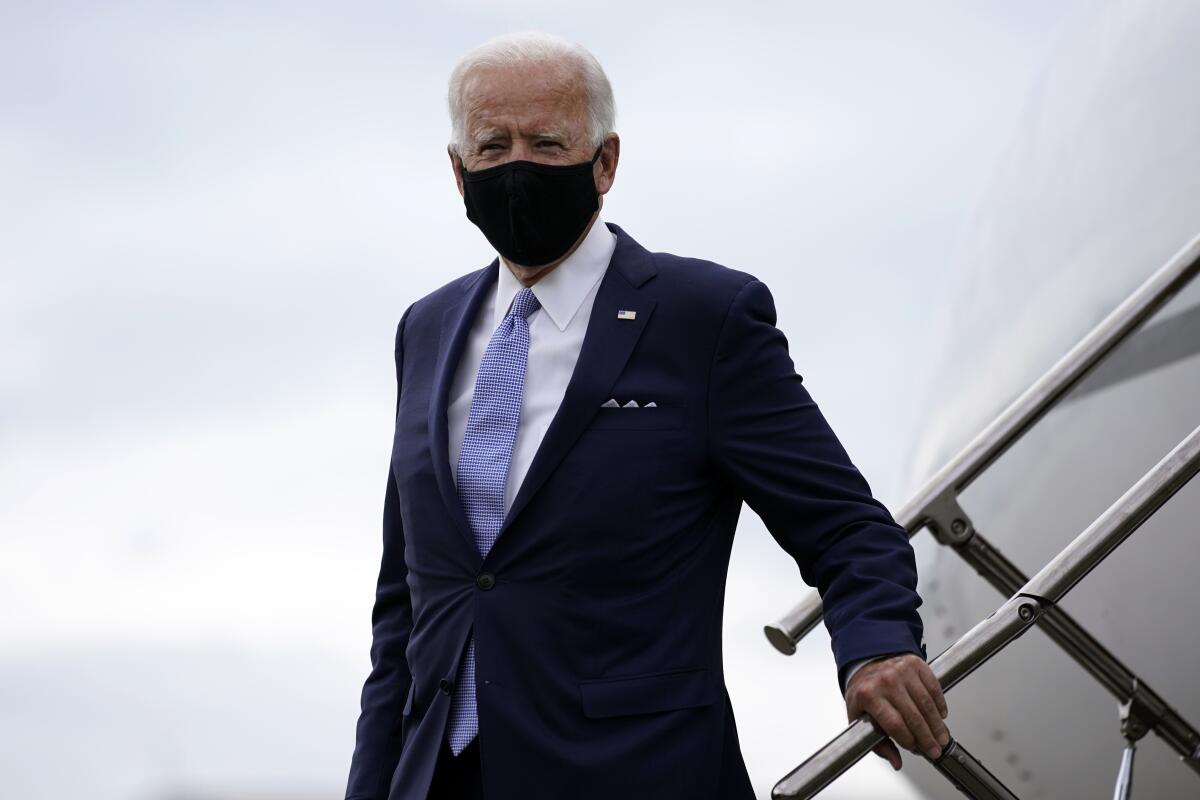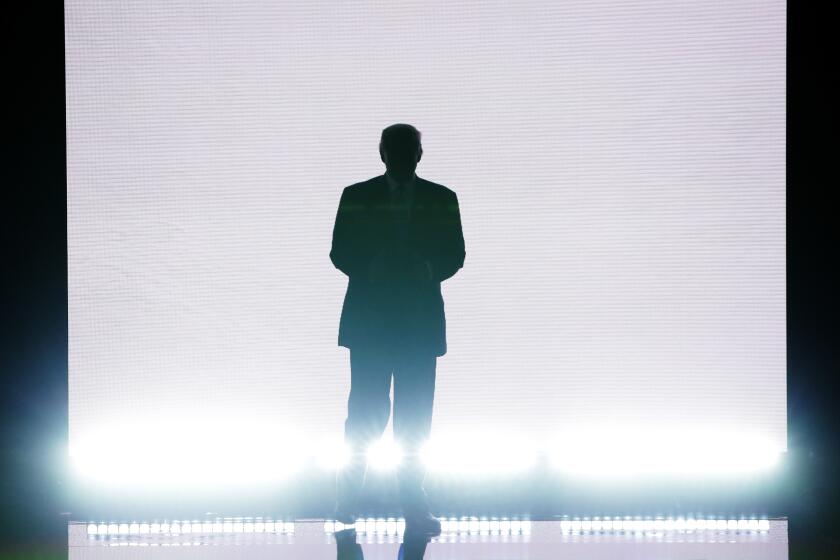Trump has slipped among key groups that backed him in 2016

- Share via
WASHINGTON — President Trump’s support has eroded among key groups of voters who backed him in 2016 — a major reason why he continues to trail former Vice President Joe Biden and a prime motivator for the president’s reelection strategy of emphasizing violent disorder in the nation’s cities.
Trump’s decline among parts of his 2016 base is a chief finding so far from the USC Dornsife Daybreak Poll, which tracked voter preferences daily four years ago and is doing so again this year. Overall, Trump has lost support from about 9% of voters who backed him in 2016, the poll finds.
The poll shows no major shift in the race during the last two weeks, belying much speculation that the back-to-back national political conventions and violence in Portland, Ore., and Kenosha, Wis., might have changed what has been an unusually stable contest.
During the Democratic convention, Biden gained 2 percentage points and Trump lost 2 points; Trump then regained some of that ground during his convention, a week-by-week comparison of the poll’s tracking shows.
The net result is a Biden lead of 11 points, 52% to 41%, in the poll’s latest results as of Monday, after the Republican convention. A rolling average of results over the last week has been virtually the same, 53% to 41%.
“Independents who lean toward the Republican Party seem to have been temporarily swayed by Biden’s message” during the Democratic convention, said Jill Darling, the survey director for the USC Dornsife poll. That widened Biden’s lead for a bit. But “Trump’s dark view of the Democrats’ agenda seems to have swept them back into the fold, so the overall result is pretty much a wash.”
Biden’s lead is almost double the 6-point lead that the poll showed for Hillary Clinton at this point four years ago. Clinton was then on a downward track, declining from the large boost she had received from her convention.

That comparison to four years ago is based on an adjusted version of the 2016 USC Dornsife survey. The poll significantly overstated Trump’s support. It showed him leading by October when, in fact, he lost the nationwide vote to Clinton by more than 2 percentage points.
An analysis after the election showed that the poll, which tracks the views of a panel of more than 8,000 eligible voters, had over-represented rural Americans, a group who ended up leaning heavily toward Trump. The 6-point lead for Clinton represents her margin at this point four years ago once the poll was re-weighted to fix that mistake.
Another big difference from four years ago: Third-party candidates get only 2% support now, much less than in 2016, when smaller parties took 5% of the vote.
While a record number of Americans — perhaps as many as 150 million — are expected to vote in this fall’s elections, the vast majority already have made up their minds. Over the next two months, the two sides will pour huge amounts of time and money into maximizing turnout among their supporters. At the same time, they’ll battle over the small slice of the electorate that remains up for grabs.
The poll’s findings help pinpoint who those wavering voters are — mostly independents, who are closely divided between Biden and Trump, and less partisan Republicans who may have supported Trump in the past, but have soured on him since.
Democrats and independents who lean Democratic have largely consolidated behind Biden, the poll finds.
Democrats and their allies have tried to win over swing voters by stressing Trump’s failure to control COVID-19 and the personality traits — belligerence, lack of empathy and flouting of traditional norms for presidential behavior — that many of those voters dislike.
Trump has countered with dire warnings about violence in American cities and thinly veiled appeals to racial prejudice, especially tied to white fears of Black families moving into predominantly white suburbs. He has depicted Biden as a “puppet” of “radical Democrats.”
Analysis of which voters Trump has lost since 2016 provides insight into the problem his reelection campaign faces. Because the USC Dornsife panel includes many people who responded to the poll in 2016, its findings provide direct evidence of which voters have changed their minds.
Win or lose in November, President Trump already has a legacy of domestic deregulation and global disruption. But his botched response to a deadly pandemic and a deep recession overshadow the rest.
Although Trump has lost about 9% of his 2016 voters, about 4% of those who voted for Clinton now say they will vote for Trump.
That gives Trump a net loss of 5 percentage points, which may not seem a big number, but sets up a high hurdle for an incumbent who barely eked out victory four years ago, winning by less than 1 point in each of the three states that put him over the top.
“You can’t lose 9% or 10% of the people who voted for you last time” and still win, said Bob Shrum, the director of USC Center for the Political Future, which co-sponsors the poll, and a veteran Democratic strategist. “If that holds, it would be catastrophic for him.”
The Trump campaign hopes to make up its losses by spurring turnout among conservative white voters who did not cast ballots in the last election. That’s possible — states like Wisconsin, Pennsylvania and Michigan have large numbers of such voters. So far, however, it isn’t happening, the poll indicates: Among people who did not vote in 2016, because they either chose not to or weren’t old enough, Biden leads 52% to 34%.
Several groups have moved away from Trump:
Among people of color who cast ballots for Trump in 2016, nearly 1-in-5 now say they back Biden, the poll found. Among Latinos, about 1 in 4 say they will vote for Trump this year, down from more than 3 in 10 last time.
Among voters who live in rural areas — Trump’s stronghold — his vote among men has remained stable but has slipped by around 10 points among women.
Trump still has a large advantage among white voters without college degrees — his core group of supporters — but his lead has shrunk. In 2016, the poll found Trump leading among that group by roughly 40 percentage points. Now it’s about 25 points.
Among whites with college degrees, meanwhile, Biden has established a significant lead. In 2016, the poll found Trump and Clinton virtually even among whites with college degrees. This year, Biden leads, 54% to 41%.
Many of those college-educated voters live in suburban areas, where voters turned heavily against the Republicans in the 2018 midterm elections. The poll shows that happening again.
In 2016, Trump and Clinton battled roughly to a draw in the suburbs. He had a large edge among white suburban men, which offset her lead among suburban voters of color; white women were closely divided.
This time around, white suburban men are more closely divided, Biden has kept the large Democratic lead among suburban voters of color, and he also leads among white, suburban women, the poll finds.
The result: a significant Biden lead among suburban voters: 53% to 40%.
Trump has sought to turn around that suburban deficit by stressing a “law and order” message. He has depicted the Democrats as an enemy to police and incapable of keeping Americans safe.
Biden has rebutted that by stressing the dangers Trump has caused, both in mishandling the COVID-19 pandemic and in stirring up sometimes violent disorder. In a speech Monday in Pittsburgh, he said Trump “sows chaos rather than providing order.”
Joe Biden rejects the Republican National Convention mantra and asks: “Does anyone believe there will be less violence in America if Donald Trump is reelected?”
The USC Dornsife poll, a joint project of the university’s Center for Economic and Social Research and the Center for the Political Future, surveys each panel member every 14 days. The current results are based on responses from 5,106 panel members.
The poll asks respondents to use a 0-to-100 scale to give the likelihood that they would support Trump or Biden. It also asks them on a separate 0-to-100 scale to give the likelihood that they will vote. Using those numbers, the poll calculates the probability of each person voting for the candidate.
In theory, because that approach uses information from all voters surveyed, it should provide a more complete look at the electorate than other polls that give people a choice between candidates but then count only the group of respondents who are deemed likely to vote.
Separately, the poll also asks respondents how they believe friends, neighbors and other people in their social circles will vote. That question shows a smaller Biden lead, 50% to 45%.
The closer result on the question about friends and neighbors could be evidence of a hidden Trump vote — people who won’t say on a poll that they’re voting for Trump, but will tell their friends. But other explanations are also possible, including that some Democrats, still stung by the upset result in 2016, simply overestimate the number of people who will vote for Trump.
As with other polls, the results are weighted so that the respondents accurately reflect Census figures for demographic characteristics including gender, race and education. The estimated error range for the poll’s full sample is roughly 1 percentage point in either direction. A complete description of the poll’s methodology, along with the text of the questions asked and the full data tables, is available on the USC Dornsife website.
More to Read
Get the L.A. Times Politics newsletter
Deeply reported insights into legislation, politics and policy from Sacramento, Washington and beyond. In your inbox three times per week.
You may occasionally receive promotional content from the Los Angeles Times.












